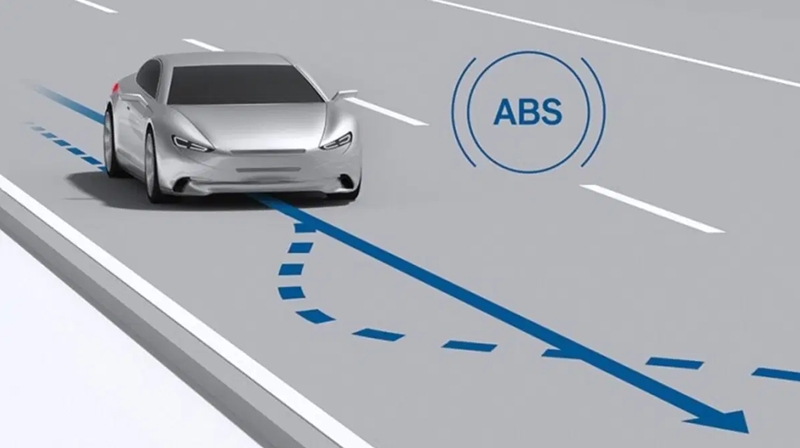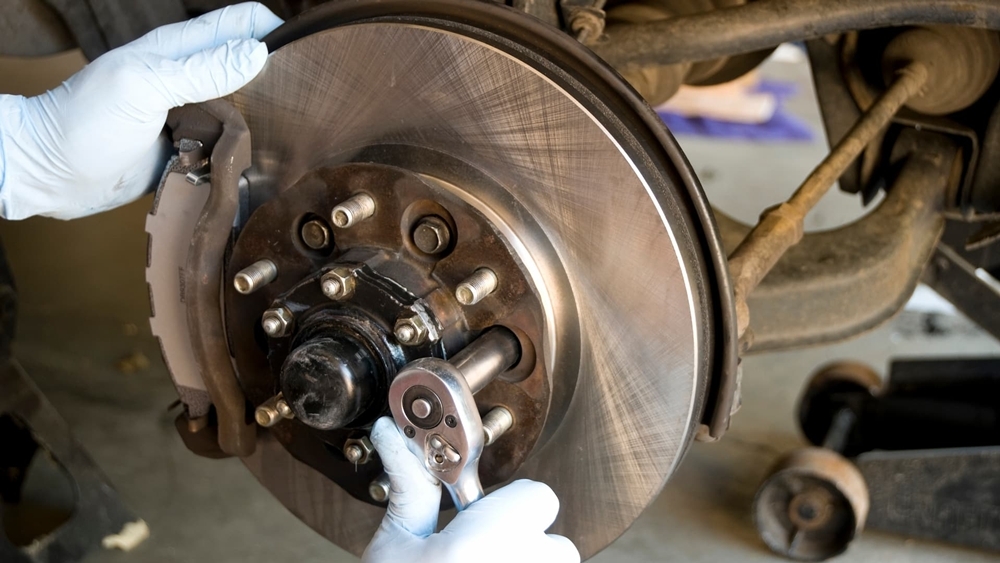Have you ever wondered what that little “ABS” light on your dashboard means? Or maybe you’ve heard people talking about ABS brakes but aren’t quite sure what makes them special? If you’re curious about how do ABS brakes work, you’re not alone.
Many drivers use this technology every day without really understanding what’s happening under the hood. Let’s dive into the world of anti-lock braking systems and discover why they’re such a game-changer for road safety.
Also read: The Complete Brake Warning Signs Guide: 11 Signs You Shouldn’t Ignore
Table of Contents
What Are ABS Brakes?
ABS stands for Anti-lock Braking System. Think of it as your car’s built-in safety net that prevents your wheels from locking up during hard braking. When your wheels lock up, they stop rotating completely, which can cause your car to skid uncontrollably across the road surface.
Before ABS technology became standard, drivers had to manually “pump” their brakes during emergency stops to prevent wheel lockup. Now, your car does this automatically – and much faster than any human could.
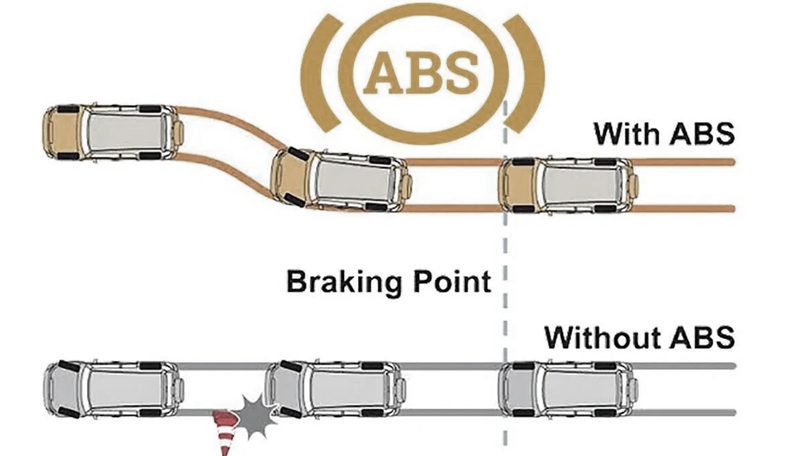
How Do ABS Brakes Work in Your Vehicle?
The magic happens through a combination of sensors, computer processing, and rapid-fire brake adjustments. Here’s the step-by-step process:
- Speed Sensors Monitor Each Wheel Your car has speed sensors on each wheel that constantly measure how fast each wheel is spinning. These sensors send this information to the ABS control module dozens of times per second.
- The Computer Detects Problems When you slam on the brakes, the ABS control module compares the speed of each wheel. If one wheel suddenly slows down much faster than the others, the system knows that wheel is about to lock up.
- Rapid Brake Pressure Adjustments Here’s where the real magic happens. The ABS system can release and reapply brake pressure up to 15 times per second – much faster than any human could pump the brakes manually. This prevents the wheel from locking while still maintaining maximum braking force.
- You Feel the Pulsing That pulsing sensation you feel in the brake pedal during hard braking? That’s the ABS system working. Many drivers mistake this for a malfunction, but it’s actually a sign that the system is doing its job perfectly.
Also read: 5 Shocking Brake Pad Replacement Cost Factors That Could Save You Hundreds
Why Understanding How Do ABS Brakes Work Matters for Your Safety
Knowing how do ABS brakes work can make you a better, safer driver. When you understand that the pulsing brake pedal is normal, you won’t panic during an emergency stop. Instead, you’ll keep steady pressure on the brake pedal and let the system do its work.
ABS doesn’t necessarily make you stop faster on dry pavement – sometimes a locked wheel can actually create more friction. However, it does something much more important: it keeps you in control of your vehicle while braking hard.

The Components Behind the Technology
Several key components work together to make ABS possible:
The wheel speed sensors are the eyes of the system, constantly monitoring rotation speeds. The ABS control module acts as the brain, processing information and making split-second decisions. The hydraulic control unit serves as the muscle, rapidly adjusting brake pressure through a series of valves and pumps.
Each component must work perfectly with the others. If one speed sensor fails, many ABS systems will shut down entirely rather than risk providing incorrect braking assistance.
Real-World Benefits You Can Count On
Modern ABS technology has proven its worth in countless emergency situations. Studies show that vehicles equipped with ABS are significantly less likely to be involved in fatal crashes, particularly in wet or slippery conditions.
The system excels on surfaces like wet roads, loose gravel, or snow, where locked wheels would cause immediate loss of steering control. By keeping your wheels rotating, ABS allows you to steer around obstacles even while braking hard.
Common Misconceptions About ABS Brakes
Many drivers believe that understanding how do ABS brakes work means knowing they will always reduce stopping distances, but this isn’t necessarily true. On dry pavement with good tires, a skilled driver might actually stop slightly faster without ABS by allowing controlled wheel lockup.
The real benefit isn’t always shorter stopping distances – it’s maintaining steering control during emergency braking. This ability to steer while braking hard can be the difference between hitting an obstacle and successfully avoiding it.
Maintaining Your ABS System
Like any sophisticated system, ABS requires proper maintenance to function correctly. Regular brake fluid changes are crucial because contaminated fluid can damage the sensitive hydraulic components.
If your ABS warning light comes on, don’t ignore it. While your regular brakes will still work, you’ll lose the safety benefits of the anti-lock system. Have the system diagnosed by a qualified technician as soon as possible.
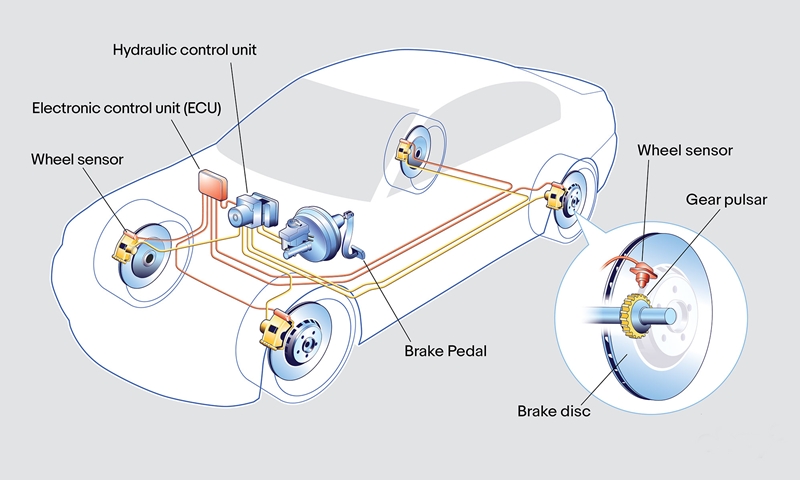
The Future of Braking Technology
Understanding how do ABS brakes work helps you appreciate how far automotive safety has come. This technology laid the groundwork for even more advanced systems like electronic stability control and automatic emergency braking.
Today’s vehicles build upon the basic ABS foundation with additional sensors and computing power, creating comprehensive safety networks that can prevent accidents before they happen.
Cost Information: ABS Brake System Repairs and Maintenance
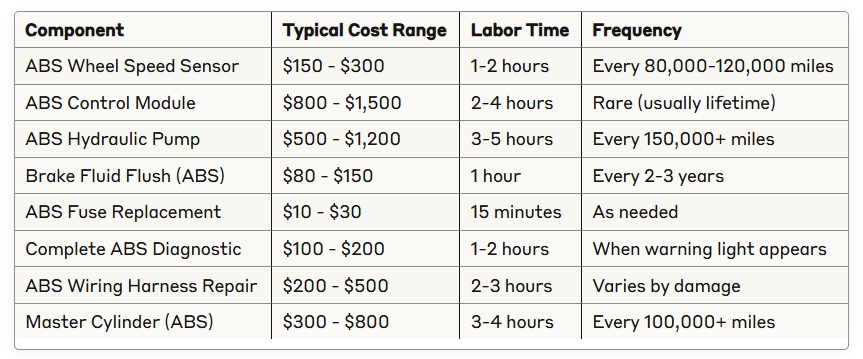
Factors Affecting ABS Repair Costs
- Vehicle make and model significantly impact parts pricing
- Labor rates vary by geographic location and shop type
- Some ABS components require specialized diagnostic equipment
- European luxury vehicles typically cost more than domestic models
Understanding these costs helps you budget for maintenance and avoid being surprised by repair bills. Regular maintenance can prevent many expensive ABS failures.
Regulatory Information: ABS Requirements Worldwide
United States Regulations
The National Highway Traffic Safety Administration (NHTSA) has required ABS on all passenger vehicles since September 1, 2013. This mandate ensures that understanding how do ABS brakes work is essential knowledge for all American drivers.
European Union Standards
The EU has required ABS on all new passenger cars since 2004, with commercial vehicles following in 2007. European regulations are often stricter than other regions, emphasizing the importance of this safety technology.
Global Implementation Timeline
- 2004: EU mandates ABS on all new cars
- 2013: US requires ABS on all passenger vehicles
- 2014: Brazil implements mandatory ABS requirements
- 2019: India requires ABS on all new cars and mini-buses
- 2021: Many developing countries adopt similar standards
Motorcycle ABS Regulations
The EU requires ABS on motorcycles over 125cc since 2016. Understanding how do ABS brakes work on motorcycles is different from cars due to weight transfer dynamics during braking.
Commercial Vehicle Requirements
Most developed countries now require ABS on commercial trucks and buses. These systems are more complex due to multiple axles and varying load conditions.
Safety Statistics: ABS Effectiveness Data
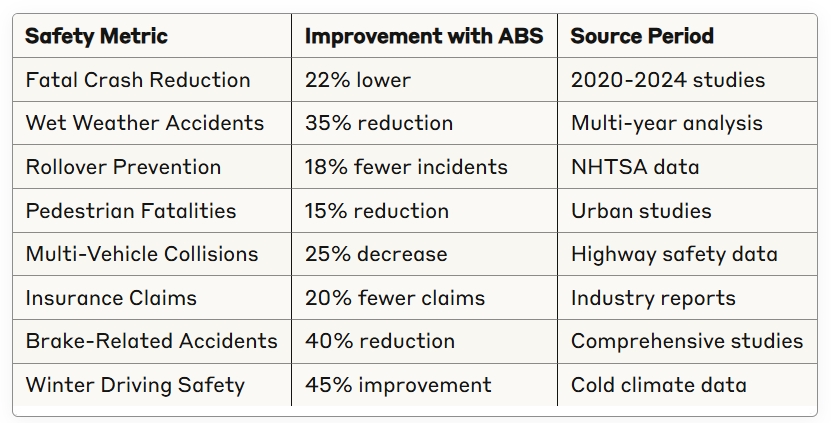
Real-World Impact Statistics
- Vehicles with ABS are involved in 6% fewer fatal crashes overall
- ABS reduces the likelihood of running off the road by 35%
- Stopping distance improvements vary: 10-40% better on wet surfaces
- Driver confidence increases 60% when they understand how do ABS brakes work
Motorcycle-Specific Data
- Motorcycles with ABS show 31% fewer fatal crashes
- Wet weather motorcycle accidents reduced by 43% with ABS
- Rider injury severity decreases significantly with ABS-equipped bikes
Economic Benefits
- Annual healthcare cost savings: $2.3 billion in the US alone
- Insurance premium reductions average 5-10% for ABS-equipped vehicles
- Vehicle resale values typically 3-5% higher with ABS
These statistics demonstrate why understanding how do ABS brakes work is crucial for every driver. The technology has proven its worth through decades of real-world data, making it one of the most effective automotive safety innovations ever developed.
Regional Variations
Different regions show varying levels of ABS effectiveness, often correlating with road conditions, driver education, and vehicle maintenance standards. Countries with better ABS education programs show higher statistical benefits.
Troubleshooting Signs: When Your ABS System Needs Attention
Understanding how do ABS brakes work includes recognizing when something goes wrong. Your vehicle will usually give you warning signs before complete system failure occurs. Pay attention to these key indicators that suggest your ABS needs professional inspection.
Warning Light Activation
The most obvious sign is your ABS warning light staying illuminated on your dashboard. This light indicates the system has detected a problem and may have disabled itself to prevent unsafe operation.
Unusual Brake Pedal Behavior
If your brake pedal feels spongy, sinks to the floor, or requires more pressure than usual, this could indicate ABS hydraulic problems. Normal ABS pulsing during hard braking is expected, but constant pedal irregularities are not.
Strange Noises During Braking
Grinding, clicking, or unusual humming sounds when braking may indicate failing wheel speed sensors or problems with the ABS hydraulic pump. These components are crucial for how do ABS brakes work properly.
Longer Stopping Distances
If you notice your vehicle takes longer to stop than usual, especially on wet or slippery surfaces, your ABS system might not be functioning correctly. This is particularly dangerous and requires immediate attention.
Uneven Braking or Pulling
When one wheel’s ABS sensor fails, you might experience uneven braking force or the vehicle pulling to one side during stops. This affects the balanced operation that makes ABS effective.

FAQ: How Do ABS Brakes Work
-
What does ABS stand for and how do ABS brakes work?
ABS stands for Anti-lock Braking System. These brakes work by preventing your wheels from locking up during hard braking situations. The system uses wheel speed sensors to monitor each wheel’s rotation and automatically adjusts brake pressure up to 15 times per second to maintain traction and steering control.
-
How do ABS brakes work differently from regular brakes?
Regular brakes can cause wheels to lock up and skid when you apply too much pressure. ABS brakes work by automatically “pumping” the brakes for you, releasing and reapplying pressure rapidly to prevent wheel lockup while maintaining maximum stopping power.
-
Why do I feel pulsing in my brake pedal when ABS activates?
The pulsing sensation is completely normal and indicates your ABS system is working properly. This happens because the system rapidly releases and reapplies brake pressure. When you feel this pulsing, maintain steady pressure on the brake pedal and let the system do its job.
-
Do ABS brakes always stop my car faster?
Not necessarily. On dry pavement with good tires, ABS might not reduce stopping distances compared to skilled threshold braking. However, the main benefit isn’t shorter stops – it’s maintaining steering control during emergency braking, which can help you avoid obstacles.
-
How do ABS brakes work in different weather conditions?
ABS brakes work exceptionally well in wet, icy, or slippery conditions where wheel lockup is most likely to occur. The system prevents skidding and maintains steering control, which is crucial for safety on slippery surfaces. This is where ABS truly shines compared to conventional braking systems.
-
What are the main components that make ABS brakes work?
The system consists of wheel speed sensors that monitor rotation, an ABS control module that processes information, and a hydraulic control unit with valves and pumps. These components work together seamlessly to prevent wheel lockup during braking.
-
How do ABS brakes work when one component fails?
If a wheel speed sensor or other critical component fails, most ABS systems will deactivate entirely rather than provide potentially dangerous partial assistance. Your regular brakes will still function normally, but you’ll lose the anti-lock benefit until the system is repaired.
-
Can I turn off my ABS system if I don’t want it?
Most modern vehicles don’t allow you to permanently disable ABS because it’s considered an essential safety feature. Some vehicles may have a temporary override for specific situations like driving in deep snow, but the system typically reactivates automatically.
-
How do ABS brakes work with other safety systems?
Modern ABS systems serve as the foundation for advanced safety features like electronic stability control, traction control, and automatic emergency braking. These systems all rely on the wheel speed sensors and hydraulic control components that make ABS possible.
-
What maintenance do ABS brakes require?
Regular brake fluid changes are essential because contaminated fluid can damage sensitive ABS components. Have your system inspected if the ABS warning light comes on, as this indicates a problem that needs professional attention to maintain full braking safety.
-
How do ABS brakes work in emergency situations?
In emergencies, apply firm, steady pressure to the brake pedal and don’t pump it manually. The ABS system will automatically modulate brake pressure to prevent lockup while allowing you to steer around obstacles. This combination of maximum braking and steering control can be lifesaving.
-
Are there any downsides to how ABS brakes work?
The main drawbacks are increased system complexity and higher repair costs compared to conventional brakes. Some drivers also dislike the pedal pulsation feeling, but this is a normal part of how the system functions and shouldn’t be concerning.
-
How do ABS brakes work on different road surfaces?
The system adapts to various surfaces by monitoring wheel speed differences. On gravel or loose surfaces, ABS might allow some controlled wheel slip to maintain stopping power while preventing complete lockup. The system continuously adjusts its response based on road conditions.
-
What should I do if my ABS warning light comes on?
If your ABS light illuminates, have your vehicle inspected by a qualified technician promptly. While your regular brakes will continue working, you’ll lose the safety benefits of anti-lock braking until the issue is resolved.
-
How long do ABS brake systems typically last?
With proper maintenance, ABS components can last 100,000 miles or more. Wheel speed sensors are the most common failure point, while the hydraulic control unit typically lasts the life of the vehicle. Regular brake fluid changes help extend system life significantly.
Need a mechanic? Find one on the Mobile Mechanic Directory
Final Thought: How ABS Brake Work
ABS brakes represent one of the most important safety advances in automotive history. By preventing wheel lockup and maintaining steering control during emergency braking, this technology has saved countless lives over the decades.
The next time you feel that familiar pulsing in your brake pedal during a hard stop, you’ll know exactly what’s happening. Your car’s ABS system is working overtime to keep you safe, making hundreds of adjustments per second that no human driver could match.
Remember, ABS is designed to work best when you apply firm, steady pressure to the brake pedal and let the system do its job. Don’t pump the brakes manually – your car’s computer has that covered.

